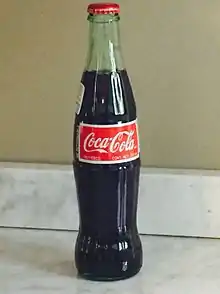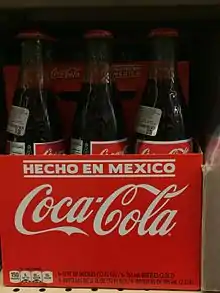Mexican Coke
In the United States and Canada, Mexican Coca-Cola, Mexican Coke (Spanish: Coca Cola de Vidrio (English: Bottle Coca Cola, or Coca Cola in a bottle)) or, informally, "Mexicoke",[1] refers to Coca-Cola produced in and imported from Mexico.[2] Mexican Coca-Cola has become popular in the United States due to its flavor, which is considered by many to differ from that of American Coke.

History
Coca-Cola opened its first bottling franchise in Mexico around 1921 with Grupo Tampico,[3] and then Grupo ARMA.[4] Monterrey-based FEMSA is currently the largest Coca-Cola bottler in Mexico, along with most of Latin America.[5]

The Coca-Cola Company originally imported the Mexican-produced version into the U.S. primarily to sell it to Mexican immigrants who grew up with that formula.[2] Mexican Coke was first sold at grocers who served Latino clientele, but as its popularity grew among non-Latinos, larger chains like Costco, Sam's club and Kroger began to stock it.[2] It is now readily available at most grocery stores throughout the United States.
In 2013, a Mexican Coca-Cola bottler announced it would stop using cane sugar in favor of glucose-fructose syrup.[6] It later clarified this change would not affect those bottles specifically exported to the United States as "Coca-Cola Nostalgia" products.[7]
Although intended for consumption in Mexico, Mexican Coca-Cola has become popular in the United States because of a flavor that Coca-Cola fans call more "natural tasting".[2] This purported difference in taste comes from Mexican Coca-cola being sweetened with cane sugar, as opposed to American-made Coke which has been sweetened with fructose since the early 1980s.[7][8]
"Mexican Coke" as sold in America can differ from Coke bottled and sold in Mexico; most of the Mexican Coke exported to the United States is made with cane sugar, while some Mexican bottlers may use high-fructose corn syrup for drinks intended for domestic sale in Mexico.[7] A scientific analysis of Mexican Coke found no sucrose (standard sugar), but instead found fructose and glucose levels similar to other soft drinks sweetened with high-fructose corn syrup.[8]
Taste
Results from taste tests have been mixed. In a taste test conducted by a local Westchester, New York magazine, tasters noted that the Mexican Coke had "a more complex flavor with an ineffable spicy and herbal note",[9] and that it contained something "that darkly hinted at root beer or old-fashioned sarsaparilla candies".[9] However, participants in a different double-blind taste test overwhelmingly preferred American Coca-Cola.[10] Participants in taste tests conducted by Coca-Cola and others reported no perceptible differences in flavor between American Coke and the Mexican formulation.[11][12]
Bottle
Mexican Coca-Cola is sold in a thick 355 ml (12.0 US fl oz) or 500 ml (17 US fl oz) glass bottle, which some have described in contrast to the more common plastic American Coca-Cola bottles as being "more elegant, with a pleasingly nostalgic shape". Formerly, Coca-Cola was widely available in refundable and non-refundable glass bottles of various sizes in the U.S., but nearly all bottlers began phasing them out and replacing most glass bottles with plastic, during the late 1980s.[9] Most exporters of Mexican Coke affix a paper sticker on each bottle containing the nutrition facts label, ingredients, and bottler and/or exporter's contact information, to meet US food labeling requirements.
Adding to the nostalgia factor, the Mexican Coca-Cola glass bottle does not have a twist-off cap (for plastic bottles) or a pull-tab (for cans). A bottle opener is required to drink the bottle's contents.
New Zealand
A similar phenomenon exists in New Zealand, where Coca-Cola is available both bottled locally (sweetened with sugar) and imported from the United States (with high-fructose corn syrup).[13]
See also
- Pepsi-Cola Made with Real Sugar, a line of Pepsi products flavored with cane sugar
References
- Phillips, Matt; Ferdman, Roberto A. (November 4, 2013). "A New Tax Might Cost Mexicoke Its Signature Sugar". The Atlantic.
- Walker, Rob (2009-10-11). "Cult Classic". New York Times.
- Davis, James R.; Davis, Adelaide B. (1998). Effective training strategies. p. 312.
The first Coca-Cola bottling company in Mexico, Grupo Tampico, with eighty-three years of history, operates a series of gas stations, computer stores, automotive retailers, hotels, and radio stations, and they still distribute Coca-Cola
- de Bell, Leendert Andrew (2005). Globalization, regional development and local response. p. 68.
Starting out in the 1920s as a small factory for ice cream and soft drinks, the company acquired one of Mexico's first franchises to bottle soft drinks under license of the Coca-Cola Company in the 1930s. In the following decades, operations...
- "FEMSA • ANNUAL REPORT 2017". FEMSA.com.
- Baral, Susmita (2013-11-04). "Mexican Coke Switching To Corn Syrup From Cane Sugar; 4 Reasons Why This Shift Is Terrible". Latin Times.
- Choi, Candice (2013-11-06). "Mexican Coke in US will still use cane sugar". yahoo.com.
- Ventura, Emily E.; Davis, Jaimie N.; Goran, Michael I. (April 2011). "Sugar Content of Popular Sweetened Beverages Based on Objective Laboratory Analysis: Focus on Fructose Content". Obesity. 19 (4): 868–874. doi:10.1038/oby.2010.255. PMID 20948525.
- Sexton, Jule (2010-02-22). "Mexican Coke Hits the County: A Blind Taste Test". Westchester Magazine. Today Media, Inc.
- López-Alt, J. Kenji. "The Food Lab, Drinks Edition: Is Mexican Coke Better?". Seriouseats.com.
- Wong, Vanessa (11 November 2013). "The Mexican Coca-Cola Myth: It's Almost American". bloomberg.com.
- Fisher, Jon (17 October 2012). "Does real sugar make Mexican Coke taste better?". sciencejon.blogspot.com.
- Steward, Ian (June 26, 2011). "American Coke fails Kiwi tastebud test". Stuff.co.nz. Fairfax Media.
Further reading
- Melnick, Meredith (2010-10-28). Study: Hey, Hipsters, Mexican Coke Might Be a Myth". Time Magazine.
